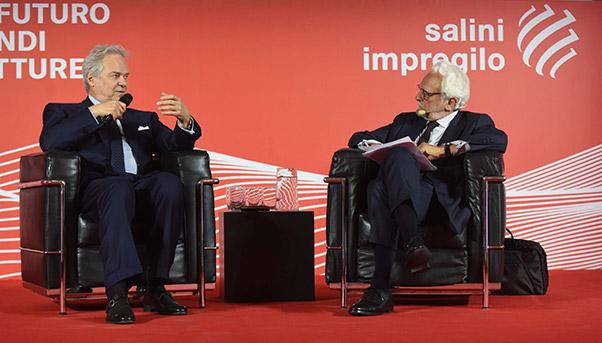
The future of infrastructure, of large public works that are capable of improving people’s lives, of projects that progress quickly thanks to the use of new technologies, will always have humans at its centre. They will always have at their core his hard work, his tenacity and his skills. Humans and the quality of their work are as fundamental today as they were in the past. They are the answer to economic megatrends and the need to find a new level of social and environmental sustainability.
The key to interpreting these new development models for the coming decades was part of a panel discussion held in Milan during the exposition of Cyclopica – The Human Side of Infrastructure. The multisensorial, photographic exposition organised by Salini Impregilo celebrates the worker and the more than one century of infrastructure projects that he and she realised throughout the world.
«Those people who a century ago built something out of nothing – big infrastructure – had a sense of the future. It is something that is missing today», said Pietro Salini, the Group’s chief executive. «Back in that time, they would plant trees, build roads and dams and think about their children, to give them certainty in the future. Today some people tend to underestimate the impact that their choices will have on future generations».
Globalisation has changed people’s perspectives, pushing back their horizons in terms of life expectations. It has also changed their view of mobility.
According to Stefano Boeri, architect and president of the Triennale di Milano museum where Cyclopica is being held until June 3, said: «The big crisis of the past decade has not stalled the growth of megalopolises. Today, big cities cover just 3% of the Earth’s surface but produce 75% of the CO2. It is obvious that these huge centres of agglomeration are the first cause of climate change. But they will be the first victims, too». Boeri said innovation had to be done at the service of protecting the environment and of a society that aims to reduce disparities among people.
Riccardo Monti, senior partner and managing director of Boston Consulting Group in Milan, also called on efforts to satisfy the need for infrastructure and bring solutions to mass urbanisation. «It is a market with enormous prospects. We’re talking about at least $1 trillion a year for infrastructure in the world», he said. Behind this evolution were three elements, he said. New technologies like three-dimensional printing, prefabrication and modularity; new digital instruments such as Building Information Modelling, Cloud computing and big data; and real-time monitoring and automation of construction. «The impact on employment will be positive. In the place of jobs that will disappear on the construction site, other skills will appear, resulting in a positive outcome», he said. The goal is to start a virtuous circle. «Growth and sustainability are inseparable tracks».
For Andrea Goldstein, an economics professor at the Catholic University of Milan: «Growth that does not lead to more poverty actually reduces it. The quality of education increases and dignified jobs are created. All of it nearly always passes through infrastructure, which is recognized by the United Nations as one of the 17 goals for sustainable development by 2030».
Marta Dassù, Senior Director of European Affairs at Aspen Institute Italia, said there is «a cultural climate that is favourable to investing in construction». In the United States, for example, the financial commitment of single states and privates is making up for federal intervention, which is still waiting for Congressional approval of President Donald Trump’s plan to invest more than $1 trillion to build and improve infrastructure.
The new frontiers in technology on construction sites will make a difference to the working conditions of the last century. But people will remain at the centre, as managers of daily activities and implementers of visionary projects.
«The element that distinguishes the quality of infrastructure is the competence of the people who design and build it», said Salini. «The secret of a company like our own is the base of our experience, and the knowedge of having done something and having done it well. This is not a static factor. Hard work is what makes us competitive on the global market. It is the work of people that transforms a machine into a beautiful machine, that produces complex infrastructure, that improves the lives of people».

